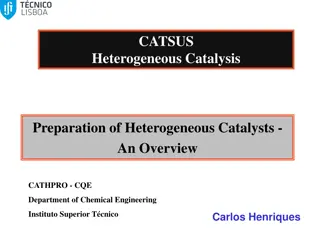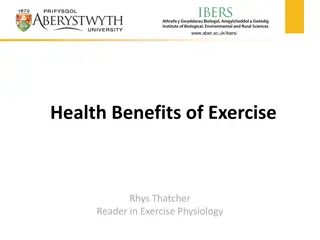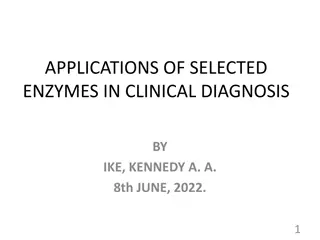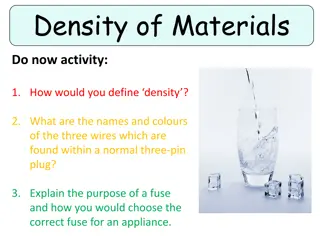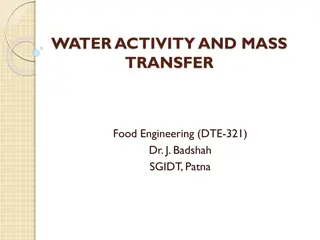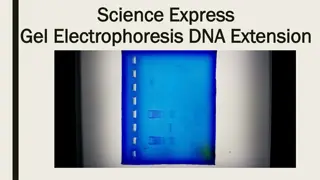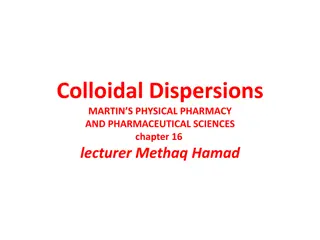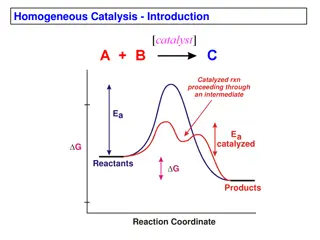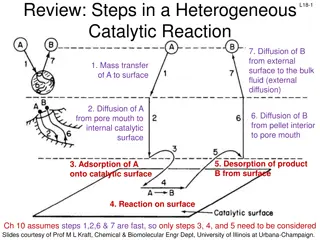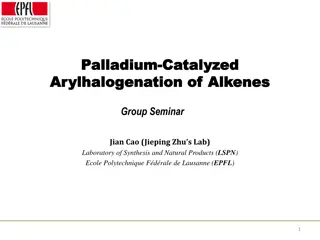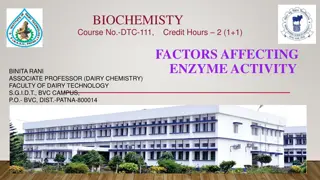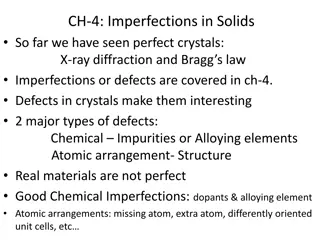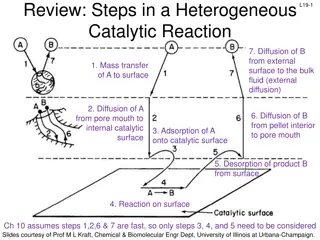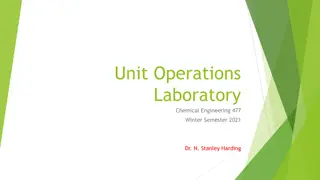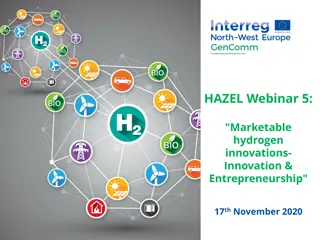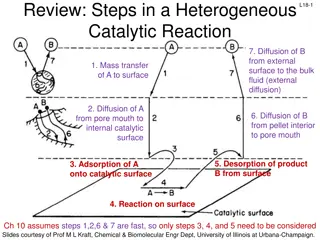Mercedes Catalytic Converter Maintenance Unveiled in Cross Roads, TX
Discover unparalleled Mercedes Catalytic Converter maintenance in Cross Roads, TX. Our expert technicians employ cutting-edge diagnostics and genuine OEM parts to ensure optimal performance and emission compliance. With swift repairs, transparent pricing, and a commitment to customer satisfaction, e
4 views • 26 slides
Transition Metals Organometallic Compounds Overview
Transition metals bonded with organometallic compounds like metal alkyls, aryls, and hydrides are common in chemistry. Ligands are crucial for stabilizing these complexes, with carbon-based ligands exhibiting diverse binding modes based on the metal's hybridization state. Preparation methods for tra
1 views • 25 slides
Understanding Half-Life in Physics
Half-life is a key concept in physics, particularly in radioactive decay. It is the time taken for the activity of a radioactive source to decrease to half of its original value. This can be determined experimentally through measuring counts per minute and graphing the data. Additionally, half-life
2 views • 11 slides
Influence of Solar Activity and Orbital Motion on Terrestrial Atmosphere
Solar magnetic field reversal, wavelet spectral analysis, and proxies for solar activity index are discussed in relation to the joint effects of solar activity and solar orbital motion on the Earth's atmosphere. The study highlights the impact of solar cycles on terrestrial climate dynamics and temp
6 views • 16 slides
Progress and Challenges in PPH Prevention and Management
Presented by Michael Muthamia, the AMPLI-PPHI program aims to reduce maternal mortality by promoting the early adoption and scale-up of new PPH treatments. With a focus on heat-stable carbetocin, tranexamic acid, and misoprostol, the program drives catalytic change through evidence generation, marke
2 views • 13 slides
Modeling and Generation of Realistic Network Activity Using Non-Negative Matrix Factorization
The GHOST project focuses on the challenges of modeling, analyzing, and generating patterns of network activity. By utilizing Non-Negative Matrix Factorization (NMF), realistic network activity patterns can be created and injected into live wireless networks. Understanding and predicting user behavi
4 views • 28 slides
Overview of Heterogeneous Catalysis and Catalyst Preparation
The development of catalytic processes involves research and development of new catalysts for better activity, selectivity, and stability. This study focuses on preparing new catalysts, determining their properties, and optimizing their development through structure-reactivity relationships. Catalys
5 views • 17 slides
Understanding Activity, Pay, and Special Codes in API Terminology
Dive into the terminology surrounding Activity Codes, Pay Codes, and Special Codes within the realm of APIs. Explore how these codes represent different aspects of scheduling, productivity, and payroll management. Gain insights into the distinctions between Activity Codes and Pay Codes, their implic
5 views • 8 slides
Benzoin Condensation: A Name Reaction Explained by Dr. Atul Kumar Singh
Benzoin condensation is a classic organic reaction where aromatic aldehydes self-condense to form α-hydroxy ketones. Dr. Atul Kumar Singh, an Assistant Professor of Chemistry, details the mechanism and the specific catalytic properties of cyanide in this reaction. The reaction involves refluxing th
0 views • 6 slides
Exploring the Health Benefits of Exercise and Physical Activity at www.aber.ac.uk/ibers/
Delve into the relationship between physical activity, fitness, and mortality through insightful studies such as the Harvard Alumni Health Study and research by Paffenbarger et al. Discover the impact of exercise on reducing the risk of dying and improving overall health. Explore early work in sport
0 views • 12 slides
Applications of Enzymes in Clinical Diagnosis: A Comprehensive Overview
Enzymes play a crucial role in cellular metabolism and are essential for various biochemical reactions in living organisms. This detailed study explores the sources, classification, properties, and factors affecting enzymes, emphasizing their applications in diagnostic and analytical processes. By h
1 views • 35 slides
Understanding Density of Materials Activity
Density is defined as the mass per unit volume of a material. In this activity, students learn to measure and calculate the density of solid objects or liquids using the density equation. They also explore the concept of density through practical examples and self-assessment tasks. Additionally, the
0 views • 16 slides
Understanding Water Activity and Mass Transfer in Food Engineering
Water activity (aw) plays a crucial role in microbial activity, chemical and physical changes in foods, and the dehydration process. Maintaining water activity below specific levels can prevent microbiological spoilage and deterioration reactions, while also affecting texture, aroma, and overall qua
0 views • 11 slides
Interactive Mystery Chart Activity for Math Classroom
Engage your students with an interactive mystery chart activity to enhance their math skills. Utilize various sets of slides based on your class's needs, including options for distance learning. Use clues to deduce the number of dice in a glass, fostering estimation skills and logical thinking. The
0 views • 19 slides
Gel Electrophoresis DNA Extension Activity in Modern Biology Lab
This lab activity uses agarose gel electrophoresis to determine the length of an unknown DNA fragment by comparing it to known DNA fragment lengths. The process involves gel preparation, loading samples, electrophoresis, staining, de-staining, and measurement of DNA bands. The activity was produced
0 views • 7 slides
Interactive Football Top Trumps Game Activity for Year 3 Students
Engage Year 3 students in a fun and educational activity centered around designing and playing Top Trumps cards featuring famous footballers from Euro 2016. Students will research player statistics, create cards, establish rules, and play the game with classmates to enhance literacy and numeracy ski
0 views • 7 slides
Principles of Green Chemistry: Catalysis and Bio-Catalysis
The 9th Principle of Green Chemistry emphasizes the use of catalysis to improve reaction efficiency and reduce waste generation. Catalytic reagents enhance selectivity, reduce energy consumption, and minimize the need for stoichiometric reagents. Green catalysis, especially bio-catalysis using enzym
0 views • 25 slides
Factors Affecting Enzyme Activity and Catalysis
Enzyme activity is influenced by various factors such as enzyme concentration, temperature, pH, substrate concentration, inhibitors, activators, and physical agents. The rate of enzyme-catalyzed reactions is directly proportional to enzyme concentration, and temperature plays a significant role with
0 views • 23 slides
Gas Detector Alarms Market Future Prospects 2030
Global Gas Detector Alarms Market Breakdown by Type (Electrochemical sensors, Catalytic sensors, Infrared sensors, Photoionization sensors, Others) by Modality (Portable, Fixed) by End-Use Industry (Oil & Gas, Chemical & Petrochemical, Metal & Mining
1 views • 8 slides
Understanding Peroxidase Enzyme Activity in Biological Samples
Demonstrating the enzyme activity of peroxidase, an enzyme that plays a crucial role in breaking down hydrogen peroxide in various organisms. Learn about the differences between peroxidase and catalase, the calculation of enzyme activity, and the significance of extinction coefficient in enzyme assa
0 views • 8 slides
Understanding Colloidal Dispersions in Physical Pharmacy
Colloidal dispersions consist of particulate matter distributed throughout a medium. They can be classified based on particle diameter, with molecular, colloidal, and coarse dispersions being common types. The enormous surface area of colloidal particles leads to unique properties, such as catalytic
1 views • 69 slides
Understanding Homogeneous Catalysis and Its Advantages
Homogeneous catalysis involves catalyzed reactions proceeding through an intermediate with lower activation energy. This method offers advantages such as selectivity, activity, ease of study, and modification but can be sensitive to deactivation. Comparing with heterogeneous catalysts prevalent in i
1 views • 14 slides
Evaluating GEF's Performance and Impact through OPS5 Consultations
The OPS5 consultations in Dakar, March 2013 aimed to assess the GEF's effectiveness in achieving its objectives, identify potential improvements, and integrate evaluative evidence across various streams including country portfolio evaluations and thematic evaluations. The study also focused on refin
2 views • 20 slides
Understanding Heterogeneous Catalytic Reactions: Key Steps Explained
In a heterogeneous catalytic reaction, various important steps occur, including diffusion of reactants, adsorption onto the catalyst surface, surface reactions, and desorption of products. Different mechanisms like single-site, dual-site, and Eley-Rideal mechanisms are involved in the surface reacti
0 views • 17 slides
Adherence to 2008 Physical Activity Guidelines & Mortality Study
This study explores the association between adherence to the 2008 Physical Activity Guidelines for Americans and all-cause mortality. It analyzes data from the NHIS and NDI to assess the risks associated with aerobic and muscle-strengthening activities. The primary objective is to evaluate mortality
0 views • 29 slides
Palladium-Catalyzed Arylhalogenation of Alkenes: Seminar Highlights
Seminar conducted by Jian Cao from Jieping Zhu's Lab at EPFL on the topic of Palladium-Catalyzed Arylhalogenation of Alkenes, covering Pd(II)/Pd(IV) and Pd(0)/Pd(II) catalytic cycles, stereochemical studies, historical development, and comprehensive research findings.
0 views • 42 slides
Understanding Activity Diagrams and State Chart Diagrams
Activity diagrams describe the workflow behavior of a system by showing the sequence of activities performed, including conditional and parallel activities. Elements such as Initial Activity, Symbol Activity, Decisions, Signals, Concurrent Activities, and Final Activity are depicted in these diagram
0 views • 10 slides
The Evolution of Cheerleading: From Yelling to Intense Physical Activity
Cheerleading ranges from yelling to intense physical activity, incorporating tumbling, dance, jumps, cheers, and stunting to motivate sports teams and entertain audiences. Originating in the United States, it has evolved from an all-male activity to a predominantly female sport with some co-ed teams
0 views • 9 slides
Virginia High School Survey 2015 Youth Risk Behavior Results
The Virginia High School Survey 2015 presented data on various risky behaviors among students, including seat belt usage, alcohol and drug consumption, weapon carrying, suicide attempts, physical activity, sexual activity, and more. The results are divided into percentages of students engaging in th
0 views • 4 slides
Interim Report of Harefield DCD Heart Transplant Programme Clinical Activity
The interim report highlights the clinical activity of the Harefield DCD Heart Transplant Programme, showcasing the feasibility of DCD heart transplantation using various methods. The report discusses donor/recipient risk profiles, feedback from medical teams, and the potential impact on national tr
0 views • 7 slides
Understanding Factors Affecting Enzyme Activity in Biochemistry
Enzyme assays measure substrate conversion to product under varying conditions like cofactors, pH, and temperature. Enzyme velocity represents the rate of a catalyzed reaction, typically reported as V0. Enzyme activity is expressed as mol of substrate transformed per minute, with enzyme unit and kat
0 views • 18 slides
Overview of Organometallic Compounds in Chemistry
Metalorganic and organometallic compounds play vital roles in organic chemistry, showcasing unique characteristics and diverse applications. From the pioneering discoveries of Cadet's fuming liquid to modern palladium-catalyzed reactions like Heck and Suzuki coupling, this field has continually evol
0 views • 18 slides
Understanding Imperfections in Solids
Imperfections or defects in crystals introduce intriguing properties to materials. This chapter explores two major types of defects - chemical impurities/alloying elements and atomic arrangement anomalies. Imperfections play vital roles in altering material properties, such as in semiconductors and
0 views • 18 slides
Understanding Heterogeneous Catalytic Reactions: Steps and Mechanisms
The content discusses the key steps involved in a heterogeneous catalytic reaction, focusing on diffusion, mass transfer, adsorption, desorption, and surface reactions. It highlights the importance of considering external diffusion effects and provides guidelines for deducing reaction mechanisms in
0 views • 40 slides
Unit Operations Laboratory Chemical Engineering Winter Semester 2021
Dr. N. Stanley Harding, a seasoned Chemical Engineering professional, introduces the Chem. Eng. 477 Unit Operations II course focusing on transferring theoretical knowledge to practical experience. The laboratory experiments cover various engineering principles such as separations, continuous distil
0 views • 13 slides
Montana State Clean Snowmobile Challenge 2019 Innovative Design Presentation
A detailed overview of the innovative design presentation from the 2019 Sierra Institute Clean Snowmobile Challenge at Montana State University. The presentation covers various advancements including a dual catalytic converter system, flex-fuel compatibility, snow flap modification, and more. The te
0 views • 10 slides
Activity Leader Guidelines for Volunteers
Welcome to the role of a leader, driver, or bus captain! As a leader, it is essential to familiarize yourself with the provided leader packets, understand the details of the activity, and prioritize safety. Taking pride in being a leader, owning the activity before the event, ensuring your packet is
0 views • 25 slides
HAZEL Webinar #5: Marketable Hydrogen Innovations in Innovation & Entrepreneurship
Building innovation into every stage of hydrogen-enabled zero emissions supply is crucial for a sustainable future. This webinar focuses on the potential of green hydrogen innovations and their role in achieving climate objectives. Key topics include GenComm & HAZEL introduction, innovation foundati
0 views • 16 slides
Understanding Steps in Heterogeneous Catalytic Reactions and Adsorption Mechanisms
This review discusses the steps involved in a heterogeneous catalytic reaction, focusing on diffusion, mass transfer, adsorption, and desorption processes. It details the site balance, surface reaction mechanisms, and desorption steps, providing insights into the complexities of catalytic processes.
0 views • 17 slides
Identifying Common BMW Catalytic Converter Problems Expert Diagnosis and Repair Services
Discover how to identify common BMW catalytic converter problems, including poor engine performance, strange smells, and warning lights. Learn expert diagnostic techniques and the importance of timely repairs to ensure your BMW\u2019s optimal perform
1 views • 24 slides






